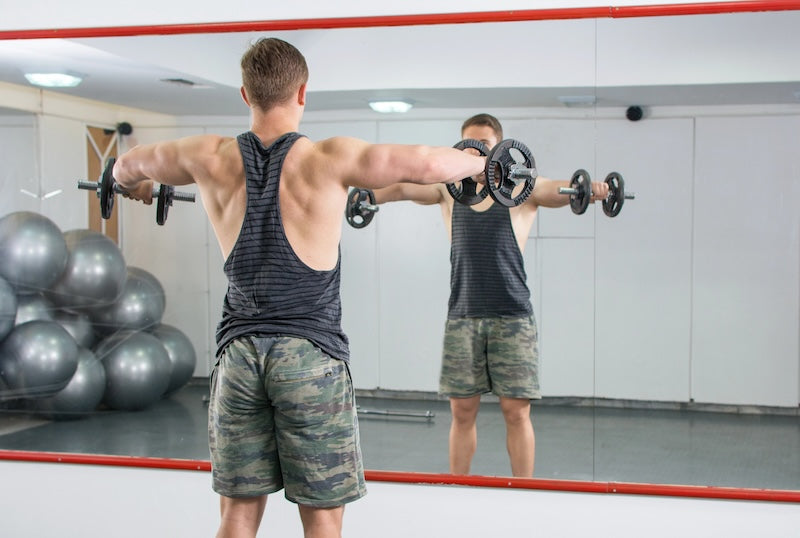Despite consistent training in the gym to successfully reach your fitness goals and achieve muscle growth, there may come a time when you're forced to take a break from your exercise regimen.
Whether your routine has been disrupted from an injury, work, school, or family commitments, it's common to worry about if you will lose fitness.
Anyone will inevitably lose muscle mass when they stop strength training. However, the time it takes to lose it is probably longer than you think.
This article will explain how long it typically takes to start losing muscle, and how to avoid losing your gains if you're forced to take a break from your training.
How Long Does It Take For You To Lose Muscle If You Stop Working Out?

It typically takes around 2-4 weeks without strength training before you start losing muscle. In addition, after 2-4 weeks strength, cardio, and many other fitness markers will likely start to decline as well.
Studies have shown that we can keep around the same amount of muscle size, strength and power after 3 weeks of not training.
Muscle Protein Synthesis Decline (MPS)
MPS can decline in as little as 4 days of inactivity. However this regression doesn't necessarily translate immediately to a decline in muscle size or strength performance.
When you start training again, muscle memory will kick in and you'll be able to get back to building muscle quicker than you think.
Different Factors Influencing Muscle Loss

The length of time it takes to lose muscle mass, will vary for different people, depending on a variety of factors.
The main factors that influence muscle atrophy include activity level, fitness level, age, gender, and diet.
Activity Level
Perhaps the biggest factor in how long it takes your body to lose muscle is how active you are during your downtime.
If you're completely inactive once you take a break from your routine, you're more likely to experience muscle atrophy faster.
On the other hand, the more active you are outside of workouts, the better your chances of retaining muscle throughout your break.
Fitness
People with a higher fitness level generally lose muscle mass at a slower rate over periods of detraining compared to the general population, and take a little longer before muscle loss kicks in.
Professional athletes for example have a high overall fitness level and would be more likely to experience a slower decline in muscle mass. Plus, athletes would expect to see a quicker regain in strength and muscle mass once they resume training.
Essentially, the more fit you are, the slower you will lose muscle mass. Plus, the more fit you are, the quicker you'll be able to start building muscle when you get back to your routine.

Age
Both strength and muscle mass declines at a faster rate in older people.
One study found this decline in strength and muscle mass can be from 16.6% to 40.9% higher in adults who are over 40 years old.
Another study that tested the rate of fitness decline during detraining for older adults found that those in the 74-86 age group declined faster than those aged between 60 and 73.
Gender
Both men and women are at risk of losing muscle mass and fitness during periods of inactivity.
One study found that muscle tissue loss as a result of disuse was higher in female, while muscle loss as a result of aging or disease was higher in males.
Diet
Finally, the health of your diet will play a part in how much muscle you lose. If your calorie and protein intake drops significantly, you're more likely to see muscle mass decline at a faster rate.
However, if you're able to eat plenty of protein and meet your body's energy needs, you're more likely to maintain muscle mass for longer.
Medical Conditions
There are certain medical conditions that might make it more difficult to maintain muscle mass.
Autoimmune conditions, hormonal imbalances, and conditions that cause systemic inflammation can interfere in the way in which muscle protein synthesis occurs.
Losing Cardio & Endurance

Aside from muscle mass and strength, your cardio fitness and endurance capacity start to decline after some time not exercising.
Researchers found that cardio fitness declines faster than muscle strength and size. One study found that athletes' endurance declined by 4 to 25 percent after 3 to 4 weeks without training, while another found significant reductions in VO2 max within 2 to 4 weeks of detraining.
Will You Lose All Progress If You Stop Working Out?
No – it's unlikely that you'll go right back to square one if you're unable to work out for a few weeks. Remember, muscle loss doesn't happen all at once.
Most studies find that we retain muscle mass, strength and power for at least 2-3 weeks of no training.
Fitness Level Can Be Regained After a Short Break
After two to three weeks of no training, the decline in fitness happens gradually, not all at once.
Most research seems to indicate that after a short break, you can get back to your prior fitness level once you resume training, even if some loss of mass and strength has occurred.

How to Minimize Muscle & Strength Loss While Not Exercising
You don't need to stress too much about losing strength and gains if you can't exercise for one to two weeks. For example, if you come down with a cold, your gains won't suddenly disappear.
If you're off training for an extended period, you still may be able to retain most (if not all) of your gains. During your fitness break, you'll have a better chance of retaining more muscle if you stick to good habits during your downtime.
Plus, keeping healthy habits will make it easier to achieve muscle growth once you start working out again.
Let's look at a few things you can do to minimize your losses and maintain an optimal body composition even when you stop exercising.
Keep Up With Some Level of Activity (If Possible)
Even if you can't exercise like you usually do, if you can do some kind of physical activity, you will be in a better position.
Of course, if you're dealing with a very serious illness or injury where bed rest is necessary, you may have no choice in the matter. But if you have the ability to move around in your day-to-day life, it'll help you decrease your losses.
If you have a lower body injury, you may be able to exercise just the upper body. If it's the other way around, try some lower body workouts, or regular walks to keep the blood pumping. If you're lucky enough to have a personal trainer or are a professional athlete, you might be able to work together to find a routine that works for you.
Keep Your Protein Intake High

Most importantly, make sure you eat enough protein.
Giving the body a steady supply of protein will help keep the muscle building process going for a little while, and will ensure your body has the building blocks it needs to rebuild any lost muscle once you start working out again.
Check out our the grass-fed whey isolate protein powder sourced from New Zealand.
Keep Your Calorie Intake Up
Although you may not need as many calories as when you're doing intentional daily exercise, if your calorie intake drops off completely, your body may start consuming muscle for energy.
This is important to note if you have to stop regular exercise because you're sick. The body needs a lot of energy while your immune system is working overdrive, so don't forget to eat adequate nutrients.
Ensure Good Quality Sleep
Try to keep up with other good fitness and health habits, even if you're not able to work out.
Just because you are unable to keep up with your regular fitness routine, it's important to not let other bad habits happen.
Staying consistent with your sleep schedule will allow you to stay healthy and strong even if you're not exercising.
Avoid Excessive Alcohol Intake
Alcohol intake can play a role in reducing strength and gains, which is why it's a good idea to keep your alcohol intake low.
Remember, if you let yourself fall into bad habits, you'll become less fit at a faster rate. Plus, you might find it more difficult when you start building muscle again to get yourself into a good routine.
Get Back To the Gym When You Can

The longer you're off, the harder it will be to start again.
A break of a few weeks likely won't have too much of an impact. But once it gets into the realm of months, rather than weeks, you might find it's much harder to regain the same strength and consistency you had before your break.
Again, this might not be in your control, but try to get back in the gym as soon as possible. Even if you're not able to get back to your full schedule straight away, one or two workouts per week will be better than none.
Key Takeaways: How Long Does It Take to Lose Muscle?
This article explained how long it will take to lose muscle after some time out of your regular exercise routine.
Increasing muscle strength and growth is no easy feat, so it makes sense to have concern over how quickly progress will be lost if you're forced to take a step back from exercise.
While the rate at which people lose muscle depends on several factors, most people will start noticing a decrease in muscle gains after three to four weeks of inactivity. Keep in mind as well that the answer depends on other health factors including diet, activity level outside of the gym, age, and gender.
Some people may notice muscle mass and muscle strength decrease in a couple weeks after stopping strength training, but this can vary from person to person.
Because professional athletes and those with high fitness levels have high muscle mass and strength, they're more likely to see less muscle atrophy compared to the average person.
To reduce the likelihood of muscle loss, people should focus on getting good nutrition, keeping an active life outside of regular workouts if possible, and maintaining other healthy habits like getting good sleep and avoiding excessive alcohol intake.









